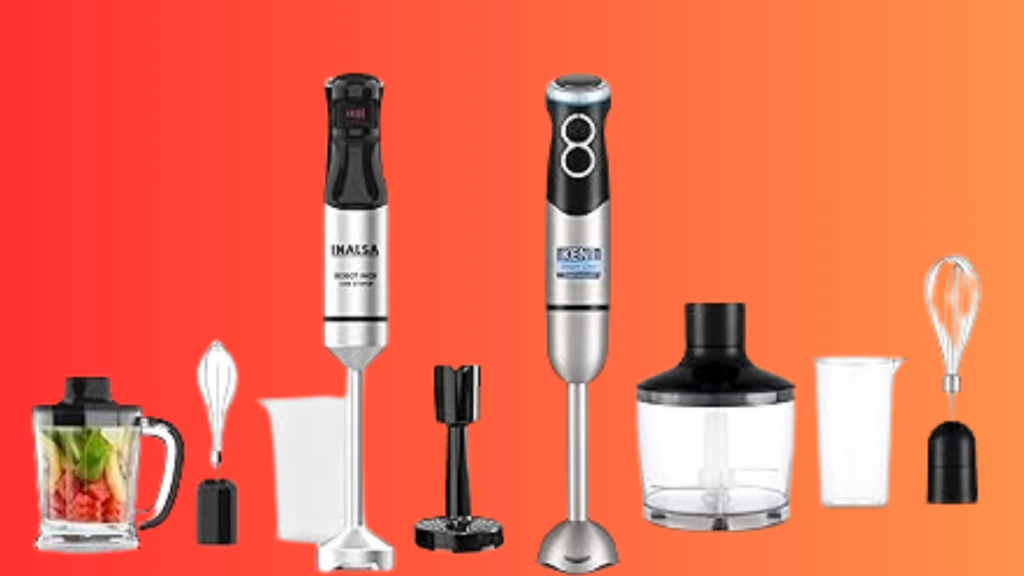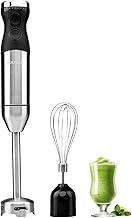
If you’re looking for a versatile, space-saving, and efficient kitchen tool, an immersion blenders (also known as a hand blender or stick blender) might be just what you need. Unlike traditional countertop blenders, immersion blenders are handheld devices that allow you to blend, puree, and mix ingredients directly in the pot, bowl, or container. In this blog, we’ll explore the uses, benefits, features, specifications, pros, and cons of this blenders to help you decide if this tool deserves a spot in your kitchen.
What is an Immersion Blender?
A portable cooking tool with a motorized handle and a detachable blending blade at the end is called an immersion blender. It is ideal for chores like whipping cream, mixing soups, and creating smoothies because it is made to be submerged straight into ingredients.
Uses of an Immersion Blender
Because of their extreme versatility, this blenders can be utilized for a wide range of tasks:
Blending Soups and Sauces: Ideal for making creamy soups right in the pot, such as butternut squash soup or tomato bisque.
Making Shakes and Smoothies:
For a quick and nutritious drink, quickly combine milk, yogurt, and fruits.
Whisking Eggs with Cream:
Certain types have whisk attachments for beating eggs or whipping cream.
Baby Food Pureeing:
For homemade baby food, purée cooked fruits or veggies with ease.
Combining Batters:
Perfect for batters for pancakes or waffles without the mess that comes with a conventional blender.
Using powerful models to crush ice:
Some expensive blenders are capable of smashing small amounts of ice.
How is an Immersion Blender Useful?
- Space-Saving Design:
- Unlike bulky countertop blenders, these are compact and easy to store.
- Convenience:
- Blend directly in the pot or container, reducing the need for transferring hot liquids.
- Easy to Clean:
- Most blenders have detachable blades that are dishwasher-safe.
- Versatility:
- With the right attachments, you can use it for blending, whisking, chopping, and more.
- Portability:
- Lightweight and cordless models make it easy to use anywhere in the kitchen.
- Because of their extreme versatility, immersion blenders can be utilized for a wide range of task
Key Features to Look For
When choosing an these blender, consider these features:
Stainless steel blades and a durable motor housing ensure longevity.
Motor Power:
Look for at least 200 watts for basic tasks and 500+ watts for tougher jobs like crushing ice.
Speed Settings: Variable speed settings give you more control over the blending process.
Attachments: Common attachments include whisk, chopper, and frother tools.
Corded vs. Cordless: Cordless models offer more flexibility, while corded models provide consistent power.
Ease of Cleaning: Detachable, dishwasher-safe parts make cleanup a breez
Build Quality: Stainless steel blades and a durable motor housing ensure longevity.
Specifications of a Good Immersion Blender
Here’s what you can expect from a high-quality immersion blender:
Material: Stainless steel blades, BPA-free plastic or metal housing
Motor Power: 200-800 watts
Speed Settings: 2-20 variable speeds
Attachments: Blending shaft, whisk, chopper, frother
Cord Length: 3-6 feet (for corded models)
Weight: 1-3 pounds (lightweight for easy handling)
Pros and Cons of Immersion Blenders
Pros:
- Compact and Portable: Takes up minimal space and easy to move around.
- Versatile: Can handle a wide range of tasks with the right attachments.
- Easy to Clean: Most parts are dishwasher-safe.
- Safe for Hot Liquids: Blend soups and sauces directly in the pot.
- Affordable: Generally cheaper than high-performance countertop blenders.
Cons:
- Limited Capacity: Not ideal for large batches.
- Less Power: May struggle with tough ingredients like ice or nuts (unless it’s a high-powered model).
- Splatter Risk: Blending at high speeds can cause splattering if not done carefully.
Best Immersion Blenders Under 5000 in 2025

Hafele Chromatic Hand Blender:
Features: 600 watts, 2-speed settings, stainless steel blades. Best For: Everyday blending tasks. 9 Variable speed control Function, Rapid Turbo Mode Technology, Stainless steel, Low Noise, 100% copper Motor
Rs.2,554 M.R.P



- Super powerful 650W motor to process even tough ingredients, with sharp steel blades for smooth blending of hot & wet ingredients.
- Detachable rust-free stainless steel rod for effortless hot/cold blending of dals, purees or preparing butter.
- Compact chopper for easy chopping, easy to clean with fewer grooves, ergonomically designed for better grip and has single button release for maximum convenience.
- Cord length of 1.2m with max 18000 RPM, ergonomically designed & easy to clean with with fewer parts & grooves.
Precautions While Using a Blender
To ensure safe and efficient use of your blender, follow these precautions:
- Read the Manual:
- Always read the user manual before using your blender to understand its specific features, settings, and safety guidelines.
- Avoid Overfilling:
- Do not exceed the maximum fill line on the blender jar. Overfilling can cause spills, leaks, or motor strain.
- Secure the Lid Properly:
- Always ensure the lid is tightly secured before blending, especially when working with hot liquids. Use the center cap (if available) to add ingredients while blending.
- Handle Hot Liquids Carefully:
- Allow hot liquids to cool slightly before blending. Use a towel to hold the lid in place to prevent steam pressure from causing spills.
- Avoid Blending Hard Ingredients Alone:
- Do not blend hard ingredients like ice or nuts without adding liquid. This can damage the blades or motor.
- Unplug When Not in Use:
- Always unplug the blender when cleaning, changing attachments, or not in use to prevent accidental starts.
- Keep Hands and Utensils Away:
- Never insert hands, spoons, or other utensils into the blender while it’s running. Use the tamper tool (if provided) for thick mixtures.
- Use on Stable Surfaces:
- Place the blender on a flat, stable surface to prevent it from tipping over during operation.
Maintenance Tips for Your Blender
Proper maintenance can extend the life of your blender and keep it performing at its best:
Some blenders allow you to sharpen the blades. Follow the manufacturer’s instructions for safe sharpening.
Clean After Every Use:
Rinse the jar, lid, and blades immediately after use to prevent food residue from hardening.
For stubborn stains, blend warm water with a drop of dish soap, then rinse thoroughly.
Deep Clean Regularly:
Disassemble removable parts and clean them with warm, soapy water. Use a brush to clean around the blade assembly.
Wipe the motor base with a damp cloth (never submerge it in water).
Check for Wear and Tear:
Regularly inspect the blades for dullness or damage and replace them if necessary.
Check the rubber gasket (if present) for cracks or wear and replace it if needed.
Store Properly:
Store the blender in a dry, cool place. If space is limited, consider storing the jar and base separately.
Avoid Overheating:
Do not run the blender continuously for more than 1-2 minutes at a time. Allow it to cool between uses to prevent motor overheating.
Sharpen Blades (if applicable):
Disadvantages of Using a Immersion Blender
While blenders are versatile and convenient, they do have some limitations:
High-performance blenders can be expensive, making them less accessible for budget-conscious buyers.
Limited Capacity:
Most blenders have a maximum fill line, making them unsuitable for large batches.
Noise Level:
Blenders, especially high-powered models, can be noisy and disruptive.
Not Ideal for All Tasks:
Blenders are not suitable for tasks like kneading dough, slicing vegetables, or grinding coffee beans (unless specified).
Splatter Risk:
Blending at high speeds can cause splattering, especially if the lid is not secured properly.
Cleaning Challenges:
While most parts are dishwasher-safe, the blade assembly can be tricky to clean thoroughly.
Power Consumption:
High-powered blenders consume significant electricity, which can increase energy bills.
Cost:
Final Thoughts
An immersion blender is a must-have tool for anyone who values convenience, versatility, and efficiency in the kitchen. Whether you’re blending soups, making smoothies, or whipping cream, this compact gadget can handle it all. While it may not replace a high-performance countertop blender, it’s a fantastic addition to any kitchen arsenal.
Ready to upgrade your kitchen tools? Check out our top immersion blender recommendations and start enjoying the benefits today!